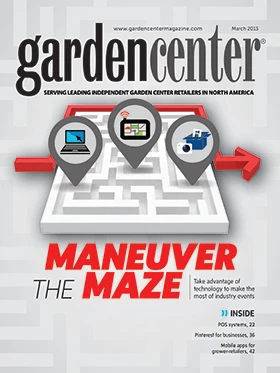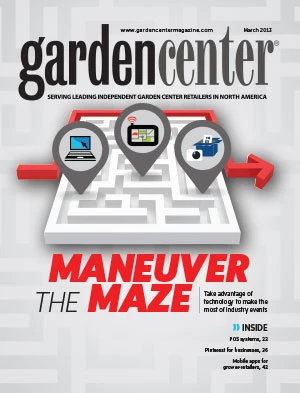
Who they are
We regularly ask successful garden center operators to tackle a question or issue pertinent to the industry. This issue’s panel of experts: Seth Nicholson, chief operations officer for The Bruce Company in Middleton, Wisc.; Chad Harris, CFO and cofounder of The Garden Gates in Metairie, La.; and Stephen Hicks, president and CEO of Hicks Nurseries in Westbury, N.Y.
 SETH NICHOLSON: The piece of technology that is most useful and profitable would be CounterPoint, our point of sale software. If used properly, it’s more than a register and inventory monitor. It can tell us who bought what when. It tells us where our customers live, if they buy on discount. For example, the majority of people from one local community only buy from us if it’s discounted, but people in another community buy mostly at full price. This is very useful in deciding where to put precious marketing dollars. The systems will assist us with merchandise sell thru schedules and show us product turns as well as what has been here too long. I could go on and on, but that’s what I think is the most beneficial technology that we have in retail.
SETH NICHOLSON: The piece of technology that is most useful and profitable would be CounterPoint, our point of sale software. If used properly, it’s more than a register and inventory monitor. It can tell us who bought what when. It tells us where our customers live, if they buy on discount. For example, the majority of people from one local community only buy from us if it’s discounted, but people in another community buy mostly at full price. This is very useful in deciding where to put precious marketing dollars. The systems will assist us with merchandise sell thru schedules and show us product turns as well as what has been here too long. I could go on and on, but that’s what I think is the most beneficial technology that we have in retail.
 CHAD HARRIS: We use this funny, silly little thing called the Internet. We as a company decided that our goal was to be an online company and explore how we could sell garden center products and things that people typically come to garden centers and nurseries to get, and how could we then sell those things online. Five years ago, if somebody told me we were going to sell a 4,000-pound fountain online that nobody ever saw, I would say, ‘You’re out of your mind.’ So what’s taken place is that we’re selling them, not one a week or a couple a month, we’re selling them every single day. If you ever told me that I could sell French bistro furniture and convince people to wait 12 weeks for it to come from France, I would tell you, ‘You’re out of your mind.’ And we do it.
CHAD HARRIS: We use this funny, silly little thing called the Internet. We as a company decided that our goal was to be an online company and explore how we could sell garden center products and things that people typically come to garden centers and nurseries to get, and how could we then sell those things online. Five years ago, if somebody told me we were going to sell a 4,000-pound fountain online that nobody ever saw, I would say, ‘You’re out of your mind.’ So what’s taken place is that we’re selling them, not one a week or a couple a month, we’re selling them every single day. If you ever told me that I could sell French bistro furniture and convince people to wait 12 weeks for it to come from France, I would tell you, ‘You’re out of your mind.’ And we do it.
 STEPHEN HICKS: Microsoft SharePoint is a tool or a set of tools that is browser-based and comes with Microsoft Windows Server that allows employees to share information and collaborate on shared calendars, shared task lists and workflows, and shared document libraries. We’ve used it to create a number of shared internal calendars. It allows us to collaborate and share so our weekly objectives, weekly calendar of events, incoming deliveries, things that are going on are documented and all be centralized in one place.
STEPHEN HICKS: Microsoft SharePoint is a tool or a set of tools that is browser-based and comes with Microsoft Windows Server that allows employees to share information and collaborate on shared calendars, shared task lists and workflows, and shared document libraries. We’ve used it to create a number of shared internal calendars. It allows us to collaborate and share so our weekly objectives, weekly calendar of events, incoming deliveries, things that are going on are documented and all be centralized in one place.
Let’s say a manager of an area sits down and comes up with [his/her] objectives for a week in [his/her] area for the staff. In the past, they may have written it down. They may have made notes. They may have kept it in their head. Now they’re off for a couple of days. And the question is, what is the priority? What’s going on? It’s less efficient for whoever has to step in and cover for them. So by documenting it in a central place, there’s visibility for the people who need to see it … and there’s also a record so next year, when we come to that same time of year, you can get a sense for what the major priorities were. We’re a seasonal business, and there are a lot of rhythms that take place year in and year out. So it’s a great communication tool that provides a lot of visibility to things that were pigeon-holed to one person’s computer or one person’s head.

Explore the March 2013 Issue
Check out more from this issue and find your next story to read.
Latest from Garden Center
- Endless Summer hydrangeas and Suntory Senetti glam up the Grammys red carpet
- Sakata Seed America announces executive leadership transition
- Syngenta Flowers launches updated Sunfinity consumer website
- Star Roses and Plants adds four members to sales team
- Super Charged Moon Juice from Moon Valley Nurseries now available nationally
- Terra Nova Nurseries releases new agastache variety, 'Peach Pearl'
- Blackmore Company creates plastic-free Plant-It-Friendly retail sleeve
- PlantCon International expands to Florida





